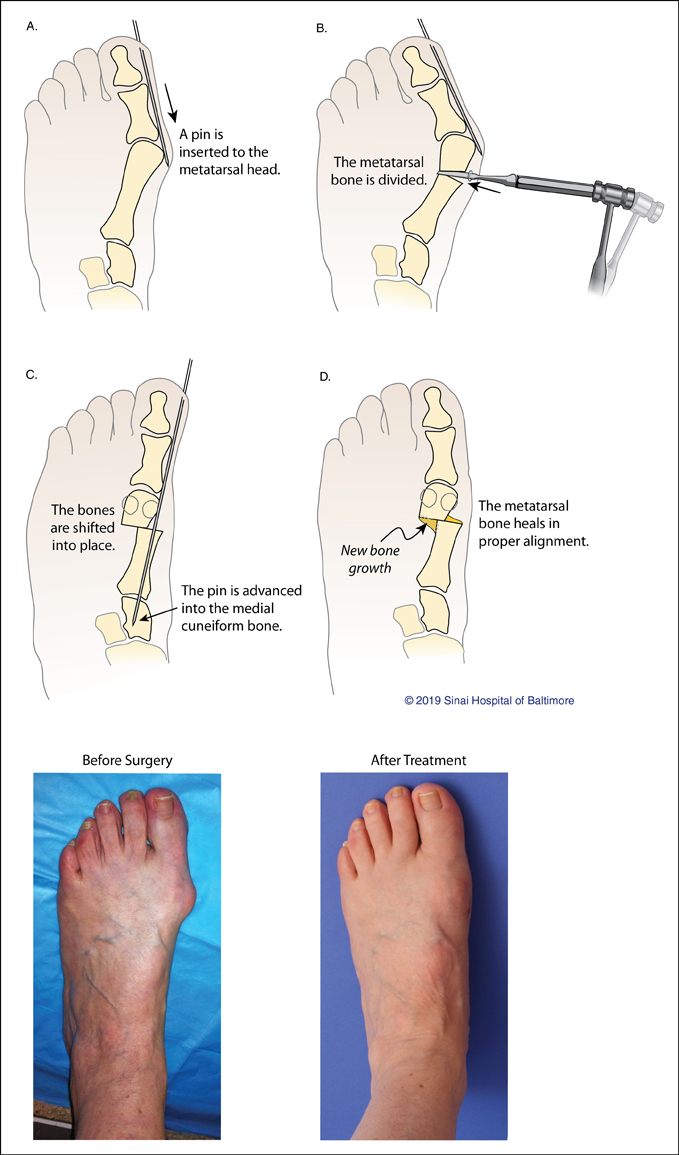Minimally Invasive Bunion Surgery
What is minimally invasive bunion surgery?
Minimally invasive bunion surgery, also known as percutaneous bunionectomy, is a surgical procedure utilizing small incisions, to correct a bunion deformity. A bunion, also known as hallux valgus, is a deformity of the big toe joint resulting in a prominent bump and deviation of the big toe towards the lesser toes. Due to the deformity, activity and shoe gear can become painful. Long standing deformity can lead to arthritis of the big toe joint.
When is minimally invasive bunion surgery a good option?
- Pain in the big toe joint
- Pain despite change in shoe gear
- Pain in everyday shoes or different types of shoes
- Drifting of the big toe towards the second toe
- Overlapping of toes
- Mild to severe bunion deformities
- All ages* (Juvenile, or pediatric bunion deformity has similar features but is sometimes considered a separate entity)
- Active individuals that require a quick return
- Utilizing small incisions, this procedure is even appropriate for the at-risk diabetic foot or for individuals whom are unable to remain non-weight bearing.
What happens during the procedure?
Through multiple small incisions on the inside of the foot, the metatarsal bone is cut and shifted. At times, an additional bone cut is required in the big toe to fully straighten the toe. Pins or screws are used to maintain correction.
- Pin fixation: after the bone is cut and shifted, a pin is inserted to hold the toe straight. The pin will stick out of the big toe temporarily for approximately 4 weeks. The pin will be removed in clinic, with minimal to no pain.
- Screw fixation: 2-3 screws will be placed in the bones to maintain correction of the bunion deformity. These screws can be removed at a later date if desired.
- Pin/Screw fixation: mixture of both pin and screw fixation. The pin will be removed in clinic at approximately 4 weeks with little to no pain. The screw will remain intact to provide additional stability once pin removed.
They type of fixation to correct and maintain the bunion repair is determined by your doctor after a detailed consultation discussing the benefits of the different methods.

How long does the procedure last?
Typically, the surgery itself will take 20-40 minutes depending on the severity of the bunion and type of fixation used. Depending on age, level of activity, quality of bone and overall health, your surgeon will discuss the most appropriate method for maintaining correction.
How long must patients stay in the hospital after the procedure?
Minimally invasive bunion surgery is an outpatient surgery. Following surgery, you will recover for 1-2 hours in the post-operative care unit (PACU) prior to discharge home.
What is the postoperative recovery?
Following minimally invasive bunion surgery, you will be able to walk immediately in a special shoe that is dispensed at the hospital prior to discharge. A dressing will be applied in the operating room which should be left intact for two weeks. At the first post-operative visit (1-2 weeks), all dressings and sutures will be removed. At that time, showering is recommended. If pins are used to maintain correction, daily pin care will be essential to prevent superficial infections. At the second post-operative visit, (approximately 4 weeks) transition into a comfortable supportive sneaker is recommended. If a pin is used, the pin will be removed at this appointment. Home physical therapy will be suggested to maintain adequate range of motion of the joint. At approximately 6-8 weeks, you can gradually return to normal, everyday activities. You can return to full activity (activities of higher demand such as sports, running, etc.) at around 10-12 weeks.
What are the benefits and risks?
Benefits of minimally invasive bunion surgery include improvement in deformity, pain and overall clinical appearance. Following surgery, early weight-bearing (first day) and a quick return to normal activity are expected. Minimal amount of pain medication is required following this procedure, because incisions are small, resulting in less swelling and pain. However, each individual patient’s pain threshold and management is individually managed to optimize minimal discomfort after surgery.
The most common risks are swelling and some initial discomfort with walking. Infections are generally low. Because of the small incisions patients can expect quicker healing of skin and lower likelihood of infections.
Why choose the International Center for Limb Lengthening for minimally invasive bunion surgery?
With a collective experience of over thirty years of helping patients with lower leg, foot and ankle problems, the Foot and Ankle Service of the Rubin Institute is one of the leading treatment centers for foot and ankle conditions in the United States. Our patients benefit from our team-centered approach with world-renowned surgeons and specialized physician assistants, nurses and physical therapists.
 Dr. Noman Siddiqui was one of the first surgeons in the United States to correct bunions through minimally invasive bunion correction. He has written and lectured on this topic in the United States and is considered an authority in the management of bunion deformity. He describes the procedure in greater detail in an article in Podiatry Today.
Dr. Noman Siddiqui was one of the first surgeons in the United States to correct bunions through minimally invasive bunion correction. He has written and lectured on this topic in the United States and is considered an authority in the management of bunion deformity. He describes the procedure in greater detail in an article in Podiatry Today.
